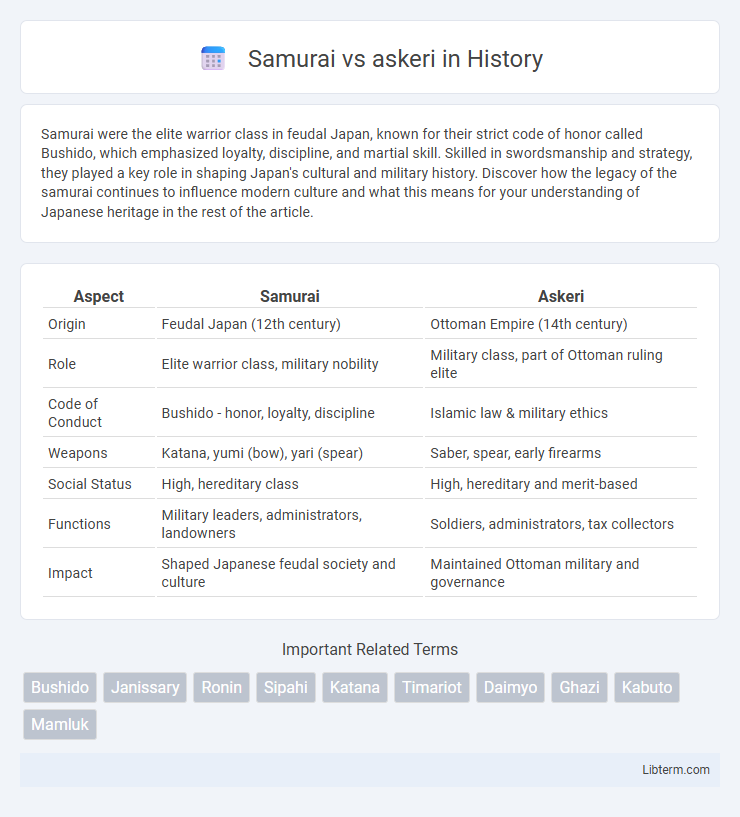Samurai were the elite warrior class in feudal Japan, known for their strict code of honor called Bushido, which emphasized loyalty, discipline, and martial skill. Skilled in swordsmanship and strategy, they played a key role in shaping Japan's cultural and military history. Discover how the legacy of the samurai continues to influence modern culture and what this means for your understanding of Japanese heritage in the rest of the article.
Table of Comparison
| Aspect | Samurai | Askeri |
|---|---|---|
| Origin | Feudal Japan (12th century) | Ottoman Empire (14th century) |
| Role | Elite warrior class, military nobility | Military class, part of Ottoman ruling elite |
| Code of Conduct | Bushido - honor, loyalty, discipline | Islamic law & military ethics |
| Weapons | Katana, yumi (bow), yari (spear) | Saber, spear, early firearms |
| Social Status | High, hereditary class | High, hereditary and merit-based |
| Functions | Military leaders, administrators, landowners | Soldiers, administrators, tax collectors |
| Impact | Shaped Japanese feudal society and culture | Maintained Ottoman military and governance |
Origins of Samurai and Askeri
The Samurai originated in 12th-century Japan as a warrior class serving the feudal lords during the Kamakura period, embodying Bushido, the code of honor and discipline. Askeri refers to the Ottoman military elite, established in the early 14th century, responsible for both administrative and combat roles within the empire. Both classes emerged from distinct cultural and political contexts, shaping their unique military traditions and societal roles.
Historical Background and Context
Samurai were the military nobility and officer caste of medieval and early-modern Japan, originating in the 12th century during the Kamakura period. Askeri refers to the military class in the Ottoman Empire, encompassing soldiers, officers, and administrators, emerging prominently from the 14th century. Both groups played crucial roles in their respective societies, with samurai upholding the bushido code and samurai culture shaping Japanese feudalism, while the askeri class maintained Ottoman military and administrative dominance through the millet system and centralization of power.
Social Structure and Class Systems
Samurai belonged to a strict hierarchical class system in feudal Japan, serving as the military nobility and held privileged status with hereditary titles and land rights. Askeri, in the Ottoman Empire, represented the ruling class including military officers, bureaucrats, and priests, exempt from taxes and holding significant influence in governance. Both classes maintained social order by upholding loyalty and martial values, but the samurai's code of bushido emphasized personal honor, while the askeri were integrated within a broader Islamic and imperial bureaucratic framework.
Training and Military Discipline
Samurai followed rigorous bushido training focused on swordsmanship, archery, and strategy, emphasizing honor, loyalty, and mental discipline. Askeri, the Ottoman military class, underwent extensive training in various warfare techniques, including cavalry and firearms, supported by strict hierarchical discipline and obedience. Both elite forces maintained strict regimens to ensure battlefield effectiveness and unwavering loyalty to their rulers.
Weapons and Armor Comparison
Samurai were equipped with katana swords, yumi bows, and yari spears, combined with lamellar armor made from small iron or leather plates bound together for flexibility and protection. Askeri soldiers typically wielded muskets, swords, and shields alongside plate armor or chainmail influenced by Ottoman and European designs, emphasizing heavy protection and ranged combat. The samurai's armor prioritized mobility and stealth, while askeri armor favored durability and defense against firearms.
Code of Ethics: Bushido vs Askeri Values
Samurai adhered strictly to Bushido, a code emphasizing honor, loyalty, courage, and self-discipline, shaping their conduct in both war and daily life. Askeri values are grounded in Ottoman military and administrative principles, prioritizing loyalty to the Sultan, discipline, and a strong sense of duty to maintain order and governance. While Bushido centers on personal honor and martial virtue, Askeri ethics emphasize hierarchical loyalty and service within a structured imperial framework.
Roles in Their Respective Societies
Samurai served as elite military nobility in feudal Japan, embodying the Bushido code that emphasized loyalty, honor, and martial skill, while also holding administrative and governance roles within their domains. Askeri were the Ottoman Empire's military class, encompassing soldiers, officers, and bureaucrats responsible for maintaining law, order, and state functions across diverse territories. Both classes played crucial roles in shaping the military structure and social hierarchy of their respective societies, with samurai blending warrior and ethical leadership, and askeri balancing military duties with civil administration.
Notable Battles and Campaigns
The Samurai, known for their mastery in feudal Japanese warfare, played a central role in pivotal battles such as the Battle of Sekigahara (1600), which secured Tokugawa Ieyasu's dominance and the establishment of the Edo period. The Askeri, Ottoman military elites, were instrumental in campaigns including the Siege of Vienna (1529), showcasing their strategic prowess in expanding Ottoman influence into Europe. Both forces demonstrated distinctive combat techniques and military structures that significantly shaped the geopolitical landscapes of their respective regions.
Decline and Legacy
The decline of samurai power accelerated during the Meiji Restoration as the Japanese government abolished the feudal system, replacing samurai with a modern conscripted army known as the "askeri." This military transformation led to the samurai losing their exclusive status and stipends, while the askeri embodied Western-style military organization and technology. Despite their fall from political dominance, samurai ideals such as Bushido continue to influence Japanese culture, ethics, and martial arts practices today.
Cultural Influence and Mythology
Samurai and askeri represent distinct martial traditions with profound cultural influence and mythology in Japan and the Ottoman Empire respectively. Samurai are deeply embedded in Bushido, the code emphasizing honor, loyalty, and discipline, shaping Japanese art, literature, and national identity for centuries. Askeri, Ottoman military aristocracy, influenced Islamic governance and storytelling, embodying ideals of valor and piety, which permeated Ottoman court culture and epic poetry.
Samurai Infographic

 libterm.com
libterm.com